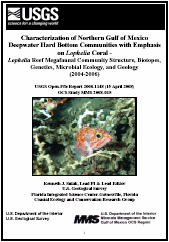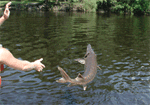Recent Publication
Characterization of Northern Gulf of Mexico Deepwater Hard Bottom Communities with Emphasis on Lophelia Coral - Lophelia Reef Megafaunal Community Structure, Biotopes, Genetics, Microbial Ecology, and Geology (2004-2006)
 There is a rapidly growing social, political, and scientific awareness of the destruction of sensitive deep coral reefs, and the potential loss of unexplored biodiversity by human activities including bottom trawling, anchoring, cable-laying, ocean dumping, pollution, and offshore oil and gas development. In the Gulf of Mexico, the Minerals Management Service (MMS) exercises an ecological stewardship role for sensitive hydrocarbon seep, hard-bottom and reef habitats relative to hydrocarbon exploration and development activities. The present U.S. Geological Survey (USGS) community structure team investigation, together with companion investigations by USGS microbiology and genetics research teams, has addressed gaps in knowledge of Lophelia pertusa (Linnaeus, 1758) deep reef ecosystems in the Gulf of Mexico, with particular emphasis on the fish and mobile invertebrate megafaunas. The overall USGS 2004-2006 program of Lophelia community studies complemented a concurrent contract study undertaken by Continental Shelf Associates (CSA, 2003) on behalf of the MMS. Download document, view video clips There is a rapidly growing social, political, and scientific awareness of the destruction of sensitive deep coral reefs, and the potential loss of unexplored biodiversity by human activities including bottom trawling, anchoring, cable-laying, ocean dumping, pollution, and offshore oil and gas development. In the Gulf of Mexico, the Minerals Management Service (MMS) exercises an ecological stewardship role for sensitive hydrocarbon seep, hard-bottom and reef habitats relative to hydrocarbon exploration and development activities. The present U.S. Geological Survey (USGS) community structure team investigation, together with companion investigations by USGS microbiology and genetics research teams, has addressed gaps in knowledge of Lophelia pertusa (Linnaeus, 1758) deep reef ecosystems in the Gulf of Mexico, with particular emphasis on the fish and mobile invertebrate megafaunas. The overall USGS 2004-2006 program of Lophelia community studies complemented a concurrent contract study undertaken by Continental Shelf Associates (CSA, 2003) on behalf of the MMS. Download document, view video clips
 Trophic coupling and habitat connectivity among coral reef, mangrove, and seagrass fishes and benthic invertebrate communities of the Virgin Islands National Park (VIIS) and Coral Reef National Monument (VICR) Trophic coupling and habitat connectivity among coral reef, mangrove, and seagrass fishes and benthic invertebrate communities of the Virgin Islands National Park (VIIS) and Coral Reef National Monument (VICR)
Marine reserves were developed to combat the decline of marine fisheries resources and biodiversity by protecting integral components of entire reef communities and interdependent habitats and species (e.g. coral reefs and seagrasses). The function of reserves is to control the "top-down" impact of human predation through "no-take" enforcement strategies, but often other factors, including habitat connectivity, stability, and food availability affect the abundance, distribution, and diversity of marine organisms. Learn More
Preserving Gulf Sturgeon—A Fish Tale of Gargantuan Proportions
 The weather is beautiful, sunny and warm, perfect for a day outdoors and on the water. It´s hard to imagine a better job than doing fieldwork with the USGS Coastal Ecology crew working to keep tabs on the Gulf sturgeon population. Almost every day in Florida is a great day to be out on the river, but it´s especially nice when it´s a workday and you have the water practically to yourself. Learn More The weather is beautiful, sunny and warm, perfect for a day outdoors and on the water. It´s hard to imagine a better job than doing fieldwork with the USGS Coastal Ecology crew working to keep tabs on the Gulf sturgeon population. Almost every day in Florida is a great day to be out on the river, but it´s especially nice when it´s a workday and you have the water practically to yourself. Learn More
Available Reports
SCIENTIFIC INVESTIGATIVE REPORT - USGS SIR 2004-5198, February, 2004 - The Benthic Community of Offshore Sandbanks: A Literature Synopsis of the Benthic Fauna Resources in Potential Outer Continental Shelf Sand Mining Areas
SYNTHESIS - January, 2005 - Taxonomic Composition and Relative Frequency of the Benthic Fish Community Found on Natural Sand Banks and Shoals in the Northwestern Gulf of Mexico. (A Synthesis of the Southeast Area Monitoring and Assessment Programs Groundfish Survey Database, 1982-2000)
SYNOPTIC CRUISE REPORT - USGS-GM-2004-03, September, 2004 - Lophelia Reef Fish & Mobile Megafauna Community Structure, Biotope Affinities, and Trophodynamics
SCIENTIFIC INVESTIGATIVE REPORT - USGS SIR 2004-5162, May, 2004 - Age & Reproduction in Three Reef Dwelling Serranid Fishes of the Northeastern Gulf of Mexico Outer Continental Shelf: Pronotogrammus martinicensis, Hemanthias vivanus & Serranus phoebe (with Preliminary Observations on the Pomacentrid Fish, Chromis enchrysurus)
SCIENTIFIC INVESTIGATIVE REPORT - USGS SIR 2004-5059, April, 2004 - Characterization of Ichthyoplankton within the U.S. Geological Survey's Northeastern Gulf of Mexico Study Area - Based on SEAMAP Surveys, 1982-1999
FINAL REPORT - CEC IR 2004-02, February, 2004 - Quantitative assessment of benthic food resources for juvenile Gulf sturgeon, Acipenser oxyrinchus desotoi in the Suwannee River estuary, Florida, USA
CRUISE REPORT - TM-2003-01, March, 2004 - Structure, Function, and Biological/Physical Coupling of Deep Reef Communites in the Northeastern Gulf of Mexico
CRUISE REPORT - CR 2003-01, February, 2004 - Assessment of Fish Communities Associated with Offshore Sand Banks and Shoals in the Northeastern Gulf of Mexico
OPEN FILE REPORT - OFR 03-54, March, 2004 - Pulley Ridge - The United States' Deepest Coral Reef? Also see: Pulley Ridge website.
TECHNICAL REPORT - USGS BSR 2001-008, OCS Study MMS 2002-034, June, 2002 - Community Structure and Trophic Ecology of Fishes on the Pinnacles Reef Tract
Archive Projects
Cold Coral Research in U.S. Waters. (People, Lands, & Water, Vol. 11 No. 2, pg. 13)
Lophelia Reef Bathymetry Maps
Posters presented at the FlSC Strategic Review in St. Petersburg, Florida, May 9-12, 2006
[Home] [Staff] [Posters]
|